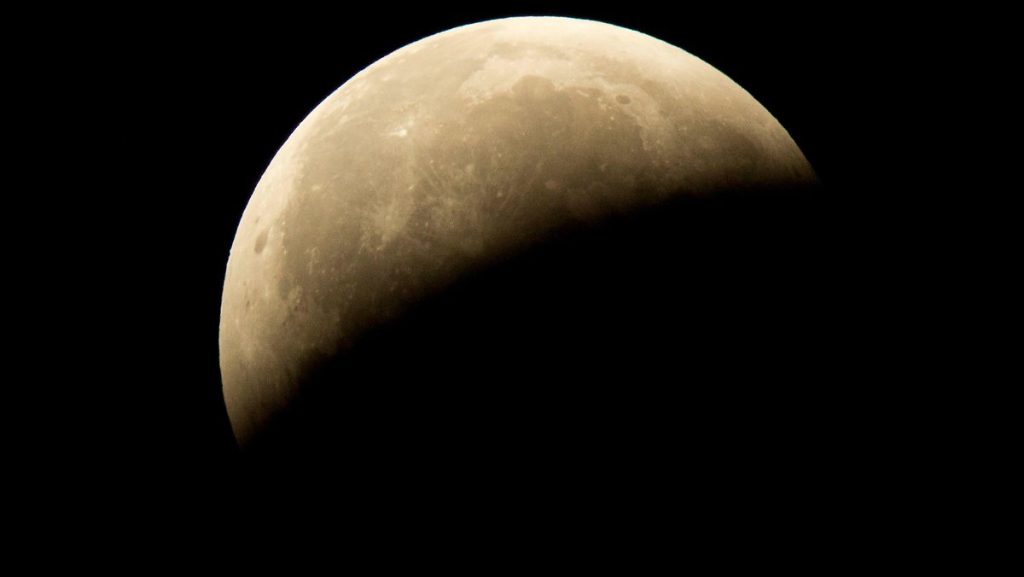Sky views in May
Total lunar eclipse in central Europe
02/05/2022, 11:09 AM (Updated)
The sky offers early risers a special spectacle in May: a total lunar eclipse. There are also a few meteors that can be seen throughout the month; Their origin is Halley’s Comet.
The notable astronomical event this month is undoubtedly a total lunar eclipse, which can be observed from Central Europe. The Cosmic Shadow play can be seen in the early hours of Monday, May 16. However, only the first part can be continued from Germany.
The moon sets before the middle of the eclipse. When the moon enters the Earth’s shadow at 4:28 a.m., the visible portion of the lunar eclipse begins. College starts at 5:29 a.m. The moon sets at 5:35 am in central Germany. The sun had already risen three minutes ago. The moon sets at 5:20 am in Hamburg, at 5:11 am in Berlin and at 5:36 am in Munich.
The next lunar eclipse that can be seen from Germany is on October 28, 2023. However, its magnitude is only 13 percent of the diameter of the lunar disk. The exact position of the full moon on the 16th is reached at 6:14 AM in Libra. The new moon occurs at 1:30 pm on the 30th. One day after the full moon, the moon approaches the Earth, being 360,300 kilometers away from us. On the fifth day, it was 405,290 kilometers from Earth.
Mercury, Venus, Jupiter, Saturn
Under favorable visibility conditions, Mercury can still be spotted just above the northwest horizon in the early days of May in the late evening twilight. The very narrow crescent moon will pass south of Mercury on May 2.
Venus remains the morning star. They always rise earlier. However, the sun appears earlier and earlier. On the twenty-seventh of the month there will be an encounter with the tender crescent of the waning moon – a beautiful sight in the eastern sky around four in the morning. Mars appears early and earlier in the second half of the night, and its brightness increases significantly. The red planet crosses Aquarius, and it enters Pisces on the nineteenth. At the end of May, Mars rises at 4 am.
Jupiter is a planet in the morning sky. The giant planet moves through the constellation Pisces. Jupiter follows Jupiter, which moves through the zodiac faster. On the 29th day, the red planet overtakes the giant planet in the south. Mars is much weaker than Jupiter, which is surpassed only by Venus in its brilliance.
Saturn becomes the planet of the second half of the night. It wanders through the constellation of Capricorn, stopping almost completely in late May. On the twenty-second, the ringed planet visits the waning crescent. On the 1st, Saturn rises shortly after 3.30 am, at the end of May already at 1.44 am. The annular planet becomes visible about 20 minutes after its ascent.
The shooting stars are active all month long
Aquatic creatures – they can be seen more in southern countries than in Germany.
(Photo: Photo Alliance / dpa)
May Aquarids are active throughout the month. These fast-fire stars have penetration speeds of 234,000 kilometers per hour into the Earth’s atmosphere. Comet origin is Halley’s comet. The maximum is expected around the fifth. Due to the fact that the radiation is very low here, we see only a few meteors in this country. But in the countries of the south, up to 20 meteors can be expected per hour.
The characteristic spring triangle in a fixed starry sky is easy to spot. It consists of the three bright stars Regulus in Leo, Arcturus in Bootes, and Spica in Virgo. The southeast sky makes a rather faint impression. The constellation Libra is not particularly pronounced, you have to consciously look for it. In the zodiac, Libra follows Scorpio, which is about to rise. Its bright red star, Antares, just passes the horizon line. In ancient times, Libra stars still denoted Scorpio’s scissors.
In the southeast the image of the serpent bearer rises with the serpent. The chariot of heaven stands high above our heads almost at its zenith. Virgo also crosses the midday line. Between Virgo and the Big Dipper, in addition to the constellation of Hounds, there is also the Hair of Berenice. This constellation is very faint, but it is made up of many stars. It works especially well if you search this area with bright binoculars.
Between bright orange Arcturus and bluish Vega, both of the brightest stars in the northern sky, there is a conspicuous stellar semicircle of the northern crown. Farther east, closer to Vega, is the sprawling but faint constellation of Hercules. A faint round spot can be seen in Hercules, which is more visible in binoculars. It is a globular star cluster with the catalog designation M13. More than a million stars can be found here at a distance of 24,000 light years.
The sun is approaching its zenith
The sun is so close that it won’t reach its peak until June. It travels through the constellation Aries and changes into the constellation Taurus at noon on the 14th. On the twenty-first at three in the morning I entered Gemini.
Midday altitude increases by about seven degrees. Day length increases by 1 hour 35 minutes in Hamburg and 1 hour 15 minutes in Munich.
(This article was first published on Saturday, April 30, 2022.)

“Tv expert. Hardcore creator. Extreme music fan. Lifelong twitter geek. Certified travel enthusiast. Baconaholic. Pop culture nerd. Reader. Freelance student.”





More Stories
Immunotherapy as conversion therapy
How did life begin on Earth? Munich researchers find important clues
Principles and features of the folk nutritional principle